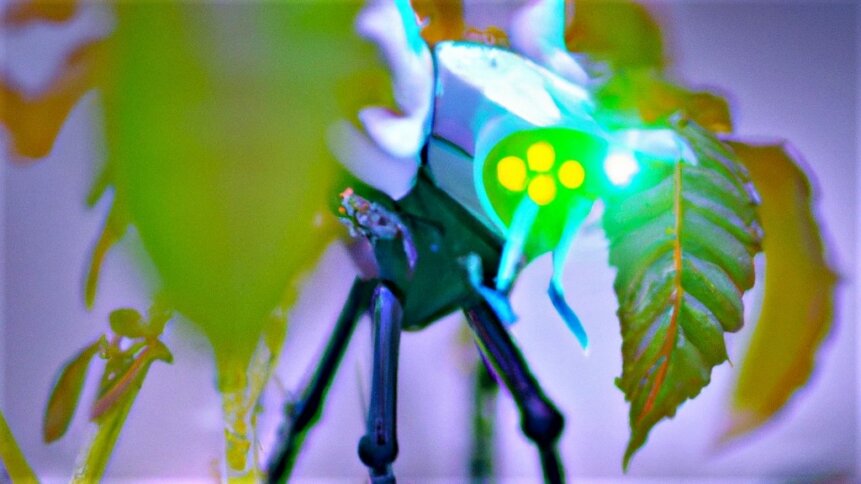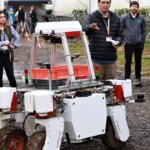Jump to it: insect robots spring into action

|
Getting your Trinity Audio player ready...
|
Agriculture is a fast-growing sector when it comes to robotics and automation. Drones are taking off in a big way, helping farmers to not just rapidly monitor acres of crops from the air, but also apply fertilizer and other chemicals. A single farmer equipped with a drone is faster than laborers in the field. Operators save money too, through the targeted application of chemicals rather than blanket spraying. Developers are designing robots for all kinds of agricultural tasks, including picking soft fruits. Another trend on the tech horizon is the use of insect robots, which has recently been boosted thanks to the integration of jumping mechanics inspired by click beetles.
“One of the grand challenges of small-scale robotics is finding a design that is small, yet powerful enough to move around obstacles or quickly escape dangerous settings,” said Sameh Tawfick, a robotics engineer based in the US. Previous studies had revealed how click beetles use so-called snap buckling to engineer a rapid release of energy that propels the creatures into the air at heights over 10x their body length. Tawfick and colleagues worked to integrate such a mechanism into insect robots and discovered that their miniature prototypes were capable of outperforming nature. The team’s designs featured a cascade of dynamic buckling that it dubs jumping with unidirectional muscles and power amplification (JUMPA).
Jumping insect robots
The lightweight energy storage and release contraption, weighing just 1.6 g and measuring 2 cm in length, allows insect robots to jump 0.9 m in the air – 40x their body length. According to the researchers, their configuration reaches the energy densities typical of the best macroscale jumping robots. And, at the same time, the mechanism’s performance matches the rapid escape times of jumping insects. Tawfick and his collaborators are keeping an open mind in terms of future applications. One idea is to equip the insect robots with cameras and use them to inspect hard-to-access regions such as cavities within jet engines. The ability to access tight spaces could also see designs being deployed for search and rescue operations.
Insect robots could benefit a wide range of sectors. “We also imagine insect-scale robots being useful in modern agriculture,” said Tawfick. “Scientists and farmers currently use drones and rovers to monitor crops, but sometimes researchers need a sensor to touch a plant or to capture a photograph of a very small-scale feature. Insect-scale robots can do that.” Miniature mechanical bots could patrol fields, jumping into crops to check their condition and send back data.
Swarms of insects typically spell disaster for crops, but hundreds of tiny flying robots could serve as an innovative technology platform for distributed sensing. Last year, we reported on the development of data-gathering smart dust that could one day be deployed to sniff out gas leaks, find people that had become trapped – for example, in a network of caves – and other novel applications. Robots are benefiting from innovations not just in miniaturization and insect-like flying and jumping characteristics. Developments in tactile materials are enabling robots that are more sensitive to objects, paving the way for the automation of delicate operations such as picking soft fruits.
Smart elastic
Tech start up Power On is commercializing the use of ‘smart elastic’ made from dielectric elastomers. The material is ideal for making soft actuators and is sometimes referred to as ‘artificial muscle’, due to its ability to contract in response to electrical impulses. According to the company, which has operations in New Zealand – where the company was founded – and Germany, tactile arrays can be retro-fitted to state-of-the-art industrial robot grippers to enable machines to feel and adjust their gripping force.
The tactile material consists of soft polymers and electrically conductive carbon, and can be deployed in various ways to benefit robotics. Smart elastic can be used as an actuator, a tactile sensing array, and even for energy harvesting – for example, recapturing some of the effort required for movement. It’s another development that adds to the design options now open to makers of all kinds of automation aids – from insect robots to industrial process equipment.
At a robotics festival held in Dresden, Germany, last year, the Power On team demonstrated its tactile technology to attendees – a mix of industry leaders, researchers, and entrepreneurs. The firm has assembled a robotic hand capable of gripping a tennis ball to demo the capabilities of crisscrossed smart elastic. And looking ahead, the company sees many more uses for what’s been dubbed soft robots. In other words, machines with enhanced sensory responses. Sectors that could benefit from soft robots include industrial automation – for example, tasks involving fragile components – e-commerce, agritech, as well as healthcare.
“We see a future where everyone makes use of intelligent robots and soft devices in daily life, at work and at home,” writes the company on its website.










